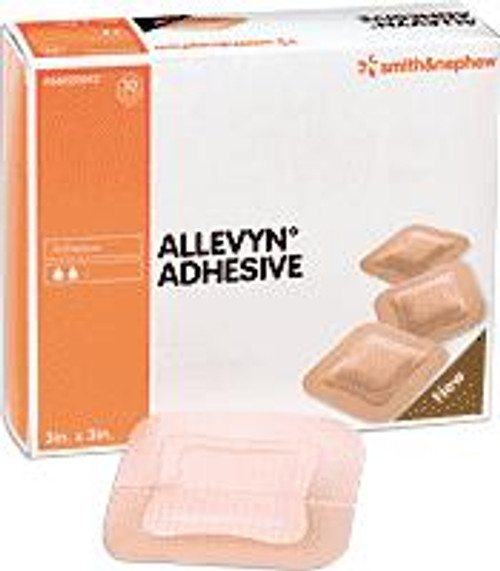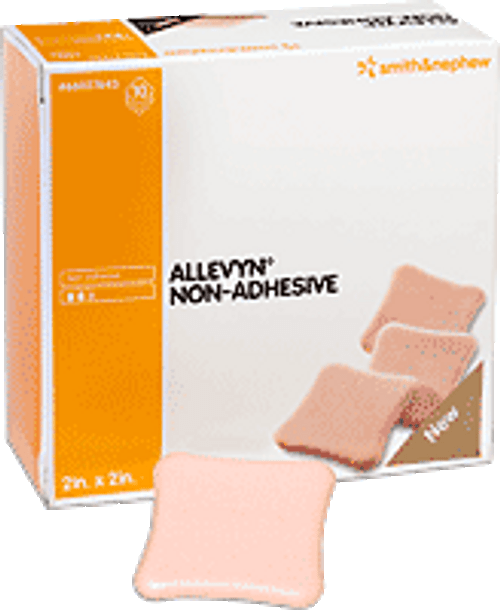Free Shipping On all orders over $100.00
ALLEVYN◊ Heel Hydrocellular Heel Dressing, Stock# 66007630
5 per box
Description
ALLEVYN◊ Heel Hydrocellular Heel Dressing
ALLEVYN◊ Heel dressing has been designed for a superior anatomical and comfortable fit to enhance management of wounds on the heel.
Features
- One piece shaped construction
- Non adhesive
- Unique trilaminate construction
- Non adherent wound contact layer
- Highly absorbent central hydrocellular layer
- Waterproof outer film layer
- Protective padding
In-vitro studies and clinical experience, both demonstrate that as healing progresses, ALLEVYN◊ dressings can stay in place for up to seven days. This capacity results from a combination of properties:
- The perforated wound contact layer allows even viscous exudate to pass into the dressing.
- The hydrocellular core of the dressing absorbs and holds liquid in its microscopic structure.
- The breathable outer surface of the dressing allows excess moisture to evaporate away from the dressing.
The result is the formation of a wound environment, which allows healing to progress without the need for frequent dressing changes.
Moist Wound Environment
ALLEVYN◊ Heel creates and maintains a moist wound healing environment at the wound surface, helping prevent eschar formation.
Designed to fit the heel
ALLEVYN◊ Heel dressing is designed to gently fit around the back of the foot allowing the wound to be dressed creating a moist wound healing environment.
Cushioned comfort
ALLEVYN◊ Heel dressings are soft and cushioning, giving excellent patient comfort.
Clean wound healing
ALLEVYN◊ Heel absorbs and retains exudate, bacteria and cellular debris, providing clean, mess free dressing changes.
- ALLEVYN◊ Heel is indicated for exudate absorption and the management of partial to full thickness wounds. Some typical wounds are:
Ulcers (venous, arterial, diabetic)
Pressure Sores
Surgical Incisions
Surgical Excisions
Burns (1st and 2nd degree)
- Creation and maintenance of a moist wound environment. Moist wound environments have been established as optimal environments for the management of the wound.
- Provides physical separation between the wound and external environments to assist in preventing bacterial contamination of the wound.
Precautions
Do not use ALLEVYN◊ dressings with oxidising agents such as hypochlorite solutions (e.g. Dakins) or hydrogen peroxide solutions, as these can break down the absorbent hydrocellular component of the dressing. Reddening of the skin around the wound has been reported rarely following the use of ALLEVYN◊ dressings. In some cases this relates to irritation of fragile skin, in others, wound exudate remaining in contact with peri-wound skin for prolonged periods may be the cause. Infrequently, cases of sensitivity to the dressing have also been reported. If reddening or sensitisation occur, discontinue use and consult a healthcare professional.
ALLEVYN◊ Heel is not indicated for use on third degree burns.
Ordering Codes / Reimbursement Information
Usual Allowable Amount: Up to 3 per week (sheet); up to 1 per day (filler).
Specific Coverage Criteria: Covered when used on full-thickness wounds with moderate to heavy exudate; sheets are covered as both primary and secondary dressings.
| Product # | Size | Pcs/Pkg | Pkgs/Case | HCPCS Code |
| 66007630 | 4-1/2" x 5-1/2" | 5 | 6 | A6210 |
Instructions For Use
Step 1:
Apply the white, patterned surface to the heel.
Step 2:
Secure with a light bandage (eg HYPAFIX◊ Non Woven Adhesive Dressing Sheet or ALBUPORE◊ Low Allergy Tearable Paper Tape).
Step 3:
During the early stages of treatment, ALLEVYN◊ Heel dressings should be inspected frequently. Dressings can be left in place undisturbed until exudate is visible and approaches the edge of the dressing. The film backing prevents fluid strikethrough and aids in the prevention of bacterial contamination of the wound.
The frequency of dressings change is affected by the nature and condition of the wound, ALLEVYN◊ dressings can be left in place undisturbed until exudate approaches the edge of the dressing, taking into consideration local clinical protocols.








